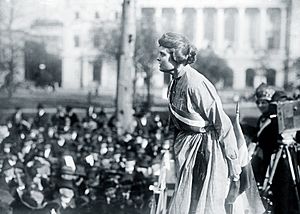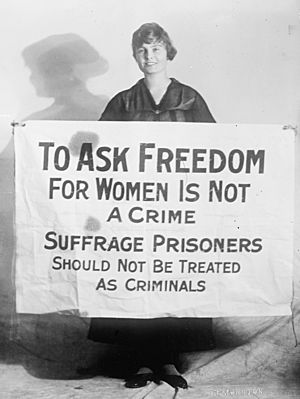Lucy Gwynne Branham facts for kids
Lucy Gwynne Branham (born April 29, 1892 – died July 18, 1966) was an American woman who worked hard for women's right to vote. She was a key member of the National Woman's Party.
Contents
Lucy Branham's Early Life and Education
Lucy Branham was born in Kempsville, Virginia. She loved learning and went to college. She earned degrees in history from Washington College in Maryland. Later, she received her Master's degree from Johns Hopkins University.
From Teacher to Activist
Before becoming a full-time activist, Lucy was a teacher in Florida. In 1915, she showed great bravery. She saved a person named Dema T. Nelson from drowning in the ocean. For this heroic act, she received a special award called the Carnegie Medal.
Lucy also started working on a higher degree, a Ph.D., at Columbia University. However, she decided to put her studies aside. She chose to focus on activism instead. She became an organizer for the National Woman's Party. This group was fighting for women to have the right to vote.
Fighting for Women's Right to Vote
In 1916, Lucy Branham became an organizer for the National Woman's Party in Utah. She worked tirelessly to help women gain the right to vote.
Protesting for Suffrage
In September 1917, Lucy took part in a protest. She joined the Silent Sentinels, a group of women who stood silently outside the White House. They were protesting because women still could not vote. For her part in these protests, Lucy was detained. She spent two months in a workhouse and a jail.

In 1918, Lucy traveled to different states. She visited Georgia, Tennessee, and Alabama. Her goal was to convince lawmakers to pass a federal law. This law would give women across the country the right to vote.
The "Prison Special" Tour
After her time in jail, Lucy shared her experiences. In 1919, she traveled across America as part of the "Prison Special" tour. This tour was organized by the National Woman's Party. Women who had been detained for protesting spoke about their experiences. They wanted to show people the sacrifices they made for women's suffrage.
Also in 1919, Lucy made a strong statement. She burned a letter from President Woodrow Wilson in Lafayette Square. This was another way to protest and demand women's right to vote.
After Women Gained the Vote
In 1920, women finally won the right to vote in the United States. This was a huge victory! But Lucy Branham's work did not stop there.
Continuing Her Activism
Lucy led a committee called the Inez Milholland Memorial Fund. This fund helped support the National Woman's Party for many years.
She also worked on international issues. She helped with Russian relief efforts. She spoke out against a blockade that was hurting Russia. Lucy worked with groups like the American Friends Service Committee. She also led the Women's Committee for the Recognition of Russia. This group was part of the Women's International League for Peace and Freedom.
Lucy also worked with the World Woman's Party in Geneva. She lobbied the League of Nations for equal rights for women around the world. In her later years, she continued to work for the Equal Rights Amendment. This amendment aimed to ensure equal rights for all Americans, regardless of sex.
Lucy's mother, Lucy Fisher Gwynne Branham, was also a suffragist. She too was detained for protesting in 1919.
Images for kids




